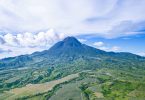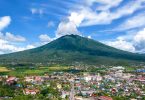Mount Pinatubo holds a significant place in the geological history of the Philippines. This once-dormant volcano unleashed one of the most powerful eruptions in the 20th century, leaving a lasting impact on the surrounding landscape and communities. Today, it stands as a symbol of resilience and rebirth, drawing visitors from around the world to witness its astonishing beauty.
Its cataclysmic eruption occurred on June 15, 1991, after being dormant for more than 6 centuries. The eruption expelled enormous amounts of volcanic ash and gas into the atmosphere, resulting in a devastating eruption column that reached an astounding height of 40 kilometers. The eruption caused extensive destruction, including the collapse of its summit.
The eruption of the volcano was a tragedy that resulted in loss of life and displacement of communities. However, from the ashes arose a renewed landscape of breathtaking beauty. The eruption created a new crater lake, aptly named Lake Pinatubo, nestled within the remnants of the volcano’s caldera. Its turquoise waters have become a striking attraction, drawing tourists who are eager to witness nature’s ability to rejuvenate itself.
The volcano has become a popular tourist destination for visitors around the world. The trek to the crater involves a thrilling off-road adventure, followed by a challenging hike through stunning canyons and vast lahar-covered landscapes. Visitors are rewarded with panoramic views of the crater lake and the surrounding mountain range upon reaching the summit.
Where is Mount Pinatubo?
Mount Pinatubo is located in the province of Zambales in the Central Luzon Region of Luzon Island. About 90 kilometers drive north west of Metro Manila, the capital of the Philippines.
Map of Mount Pinatubo
Photo Gallery
Additional Information
Read more about Mount Pinatubo. Check out the links below to learn how to get there, what to do, what to see, when to go, where to stay and many more helpful information about this attraction.







